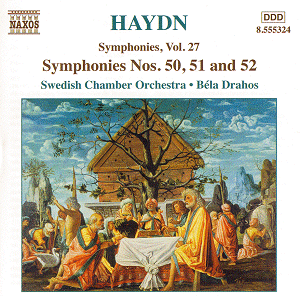This Haydn project is marching on and quickly
filling your shelf space. We are now well into his so called ‘Sturm
und drang’ period, around 1771-73, when Haydn became so radical
and experimental that his position at the court of Prince Esterhazy
was severely questioned. This style is a strong feature of the
52nd symphony and indeed some of the 51st. Not only
Haydn but also his contemporaries, Gassmann, Vanhal and C.P.E.
Bach conformed to its fashion. Its hallmarks are unison openings,
scurrying scales, wide leaps in the thematic material, rushing
repeated, often syncopated, notes in the upper strings, a bass
line hammered out in quavers, or in crotchets; all, no doubt,
part of a minor key language.
The 52nd symphony with its searching
first movement and whirlwind finale is full of this type of music.
The 51st is characterized by its use of high horns.
The Menuetto, unusually has two trios although the first one was
a later addition to offer an option to replace the much harder
2nd trio. The first horn goes well above the treble
clef; the second horn goes below the bass clef … and remember
these were the days before valves. In addition Haydn asks for
hand-stopped notes in the second movement in a high passage set
against muted strings. Obviously Haydn had a certain local virtuoso
in mind.
Keith Anderson in his excellent if analytical
essay does not mention this but H.C. Robbins Landon in the notes
accompanying another recording of the Symphonies 51 and 52 (Sony
SK 48371) with the Canadian group Tafelmusik comments that "Haydn’s
first horn player, Carl Franz was an exceptional virtuoso"
who was "reinstated into the orchestra at Esterhazy at Haydn’s
request after his earlier resignation". Perhaps it was his
return in 1771 that enabled Haydn to show off his exceptional
skill.
The 50th Symphony was probably written
for the visit of Empress Maria Theresa on August 31st
1773 (the numbering of these symphonies is quite a puzzle). Some
of its music may well have come from the music for a puppet show
(!) and the prelude to the opera Philemon and Baucis. This
probably explains the slightly obscure cover picture, Bramantino’s
‘Philemon and Baucis’ (painted c. 1500). The Fiftieth is one of
into this most celebratory of symphonies in that most jubilant
of keys, C major. It is certainly a festive and exuberant work
the first movement, in its stately introduction (a major feature
of Haydn’s later symphonies) being almost baroque in its use of
dotted rhythms.
I mentioned that I have also been listening to
the CD recorded by Tafelmusik under Bruno Weil; they play on mostly
18th Century instruments. You might expect me to say
that it is the horn solos in the 51st symphony which
come out so very differently but in truth I can find little to
comment on. It is, for me, in the sound of the strings that I
notice the contrast and in the timpani. The Swedish Chamber Orchestra
does not have the same cutting edge and attack. In the 52nd
symphony I like their repeat of the exposition giving the finale
more weight. However I don’t like the laboured way they go about
the Menuetto which is, after all, marked Allegretto. The second
movement lasting over nine minutes as opposed to Tafelmusik's
less than eight is also too slow, bland and dull and seems to
lose its way.
But these glitches will, I suspect, be irrelevant
to many of you. For less than a fiver you can continue to build
up your collection with three fine middle period works. If you
are fussy about performances and prefer original instruments then
obviously you should look elsewhere.
Very good quality recordings and a beautiful
acoustic if a little bit light on the bass.
Gary Higginson
see
also review by Colin Clarke
